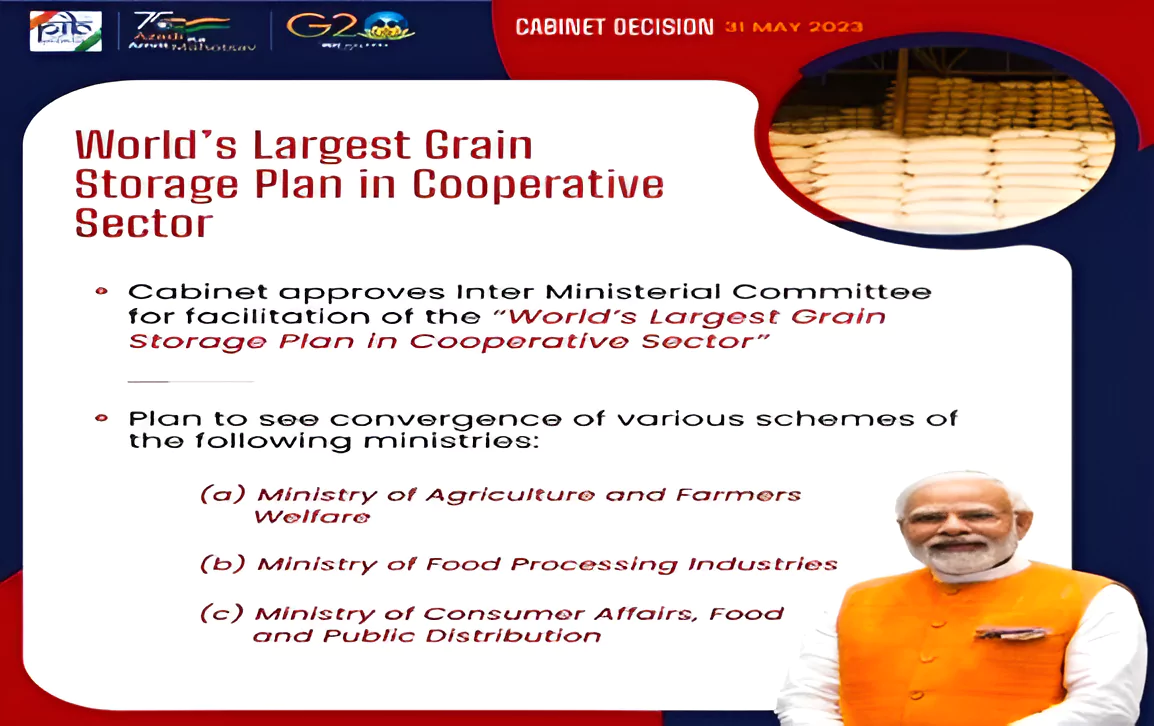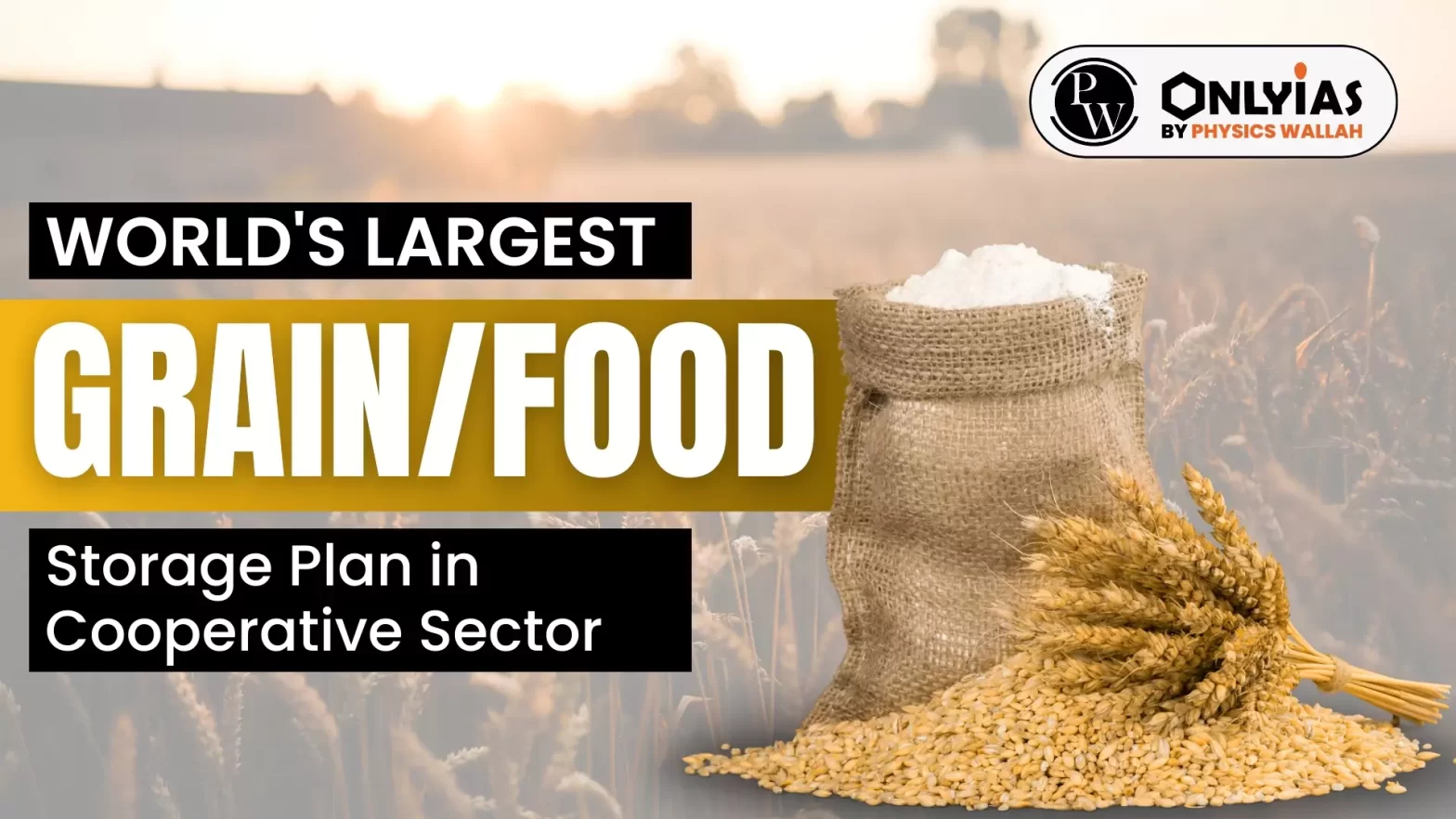Context:
This editorial is based on the news “PM Modi inaugurates 11 godowns in PACS under world’s largest grain/ food storageplan in cooperative sector” which was published in the Indian Express. Recently, the Indian Prime Minister launched the “World’s Largest Grain/ Food Storage Plan in the Cooperative Sector” to address the shortage of food grain storage capacity in the country.
About the World’s Largest Grain/ Food Storage Plan
It is poised to revolutionise agriculture and the Fast-moving consumer goods (FMCG) industry.

-
Aim of the Grain/ Food Storage Plan
-
- To set up a storage infrastructure of 700 lakh metric tons.
- To double the Existing Storage Statistics
- To set up a network of integrated grain storage facilities through PACS nationwide.
- Strengthen the Economic Condition of PACS
-
Vision of the Grain/ Food Storage Plan
- Primary Agricultural Credit Societies (PACS) from across the country will join it in the next couple of years to reach 100% storage capacity before 2027.
- To Enable PACS Participation: Creation of various agri infrastructures at the PACS level, including setting up decentralised godowns, custom hiring centres, Fair Price Shops, etc.
-
Budgetary Allocation For Grain/ Food Storage Plan
-
- Though the Grain/ food storage plan does not have a separate allocation, it will be implemented by the convergence of 8 schemes.
-
Financial Support by NABARD
-
Grain/ Food Storage Plan Implemented By
-
- The National Cooperative Development Corporation (NCDC) with the support of NABARD, Food Corporation of India (FCI), Central Warehousing Corporation (CWC), NABARD Consultancy Services (NABCONS), National Buildings Construction Corporation (NBCC), etc. in different States/ UTs.
-
An Inter-Ministerial Committee (IMC) and National Level Coordination Committee (NLCC)
-
- To ensure accountable and transparent implementation, an Inter-Ministerial Committee (IMC) and a National Level Coordination Committee (NLCC) have been formed.
- The IMC focuses on effective plan execution, while the NLCC, consisting of members from relevant Ministry/Departments and Central Government agencies, oversees and reviews overall progress.
-
- State Cooperative Development Committee (SCDC) at State level and District Cooperative Development Committee (DCDC) in each District of the State/UT have also been constituted.
Why India Needed Grain/ Food Storage Plan?
- Ensuring Food Security: India, with 11% of the global cultivable area and 18% of the world population, operates the largest food program through the National Food Security Act (2013). A strong network of foodgrain storage facilities is crucial for ensuring food security for its citizens.
- Shortage of Storage: India, with a food grain production of 311 MMT, faces a storage capacity shortage of 166 MMT (47%) compared to the global surplus of 131%.
- Embodying the Vision of “Sahakar-se-Samriddhi: The Ministry of Cooperation is implementing the ‘World’s Largest Grain/ Food Storage Plan in the Cooperative Sector‘ to realise the vision of “Sahakar-se-Samriddhi” (Prosperity through Cooperation), emphasising the economic growth potential of cooperatives.
- National Food Security Act (NFSA): The initiative seeks to ensure food security for eligible beneficiaries through subsidised grain access, emphasising the need for robust storage facilities to address deterioration challenges and prolong the longevity of seeds and crops.
- Regional Disparities: In India, the storage capacity varies across various regions. Example: Some southern states have a storage capacity of 90% and above, while northern states have capacities below 50%.
|
Advantages of Expanding Infrastructure for Grain/ Food Storage Plan
- Reduction in Post-harvesting Losses.
- Bring down the Food Grain Handling and Transportation Cost: Since PACS would be operating as a procurement centre as well as Fair Price Shops (FPS), the cost incurred in transportation of food grains to procurement centres and again transporting the stocks back from warehouses to FPS would also be saved.
- Ensuring Food Security, and
- An Efficient Food Supply Chain: by bridging the gap between farm produce and consumer demand, ensuring a stable and efficient food supply chain.
Challenges that Need to be Tackled
- Non-functional PACS: Only about 63,000 out of 1 lakh PACS are currently operational in India.
- Bureaucratic Challenges: The convergence and coordination of various schemes might present challenges.
- Multiplicity of institutions: With cross-cutting objectives are likely to dilute their effectiveness.
- Lack of Infrastructure & Technology: Setting up modern storage facilities and implementing digital solutions might pose a challenge given the rural setting and the potential lack of technological infrastructure
- On Skill Development: It would require skilled people to operate and manage the advanced storage facilities, which poses a challenge of skill development.
- Governance Issues: The involvement of agricultural cooperative societies in food storage raises concerns given the potential conflict with FPOs, which are also engaged in post-harvest handling under the government’s FPOS initiative.
- Inefficient Functioning of Agriculture Cooperatives: The implementation of the storage infrastructure along with financial responsibilities lie on the Agricultural Cooperatives. However, the functioning of agricultural co-operatives is very inefficient.
- In contrast to Agricultural Cooperatives, FPOs are being run as businesses with better governance structure.
- Maintenance of Infrastructure: India faces challenges in managing and maintaining its infrastructure, despite the ease of creating it. The record includes FCI storage, drinking water systems, irrigation systems, and more.
- Capital maintenance expenditure (Capex): is rarely incorporated into annual budgets. More importantly, none of these systems are financially viable due to various reasons.
- Other Problems: It includes elite capture,bureaucratic/political interference and poor marketing. The measures being taken to resolve them need to be spelled out.
Various Benefits to Farmers
- Farmers would have a choice to sell their produce depending on the market conditions, and not be forced into distress sale.
- They will be able to get various agri inputs and services at the Panchayat/ village level. By diversifying their businesses, farmers will be able to get additional sources of income
- Through integration with the food supply management chain, farmers can expand their market size and realise better value for their produce.
- Reduction of post-harvest loss will lead to enabling farmers to earn better prices.
|
Way Forward to Grain/ Food Storage Plan
- Quality Infrastructure: Modernising the existing storage infrastructure should be a priority, especially for perishable commodities (fruits, vegetables, milk, meat, fish, etc.).
- Investment in modern technologies: Modern technologies are vital for high-quality processing of perishables, helping extend food longevity while minimising nutritional value loss.
- Judicious Planning: India has the storage capacity for only one-eighth of its annual perishable produce. This requires judicious planning and estimation of storage requirements for different products across the regions of the country
- Revival of PACS: These societies need to be revived and made operational to receive the best of potential of the plan.
- Address Climate Change Impact: Efforts need to be made to mitigate the impact of climate change on food grain storage by using modern technologies.
- Encouragement to the Private Sector: To work on the poor track record of co-operatives, the Centre tried to encourage the private sector to invest in marketing infrastructure.
- Focus on Private-Public-People (PPP) Initiative: To gain more positivity, there would be a focus on the private- public-people (PPP) initiative along the lines of FPOs. Even bringing it under the umbrella of FPO would have been a better option.
- Use of Hermetic Storage: Hermetic storage, an airtight technology for agricultural commodities, utilises a modified atmosphere to safeguard moisture-sensitive goods. It prevents pest infestation by restricting gas exchange with the surrounding environment and ensures stored commodities are free from toxic substances like aflatoxin.
Conclusion
As India works towards achieving its global commitments and fostering sustainable agricultural practices, the storage capacity expansion plan is a shining example of India’s. dedication to economic growth, food security, and rural development.
Also Read: Farmers Protest 2.0: Are Farmers Demands Unjustified?
| Prelims PYQ (2021):
In the context of India’s preparation for ClimateSmart Agriculture, consider the following statements:
1. The ‘Climate-Smart Village’ approach in India is a part of a project led by the Climate Change, Agriculture and Food Security (CCAFS), an international research programme.
2. The project of CCAFS is carried out under Consultative Group on International Agricultural Research (CGIAR) headquartered in France.
3. The International Crops Research Institute for the Semi-Arid Tropics (ICRISAT) in India is one of the CGIAR’s research centres.
Which of the statements given above are correct?
(a) 1 and 2 only
(b) 2 and 3 only
(c) 1 and 3 only
(d) 1, 2 and 3
Ans: (d) |
![]() 28 Feb 2024
28 Feb 2024


